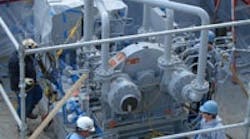Proper installation, pre-commissioning, commissioning, and startup can play crucial roles in the performance, reliability and safety of process machinery. Unfortunately, many plants lack the necessary expertise or fail to demand sufficient precision in such activities. This often results in expensive damage to machines or production interruption.
So, let's look at several key elements — machine alignment, field balancing, electrical issues, lubrication systems, and mechanical and gas seals — that frequently don't get the attention they deserve during installation and commissioning.
MACHINE ALIGNMENT
Good alignment can greatly extend bearing and seal life, lower vibration, improve reliability, and foster better overall performance. Improper alignment can cause excessive vibration, premature wear and early failure. Adequate clearance for each machine casing (for example, driver, gear unit and driven equipment) is essential to permit proper alignment. Some experts recommend a shaft interface fit (alignment tolerance) of around 0.0005 times the shaft diameter (approximately 0.01–0.02 mm for typical 25–50-mm shaft diameters). Some textbooks suggest an alignment tolerance of around 0.01 mm overall, regardless of shaft diameter. Special rotating machine trains may need tighter alignment tolerances. On the other hand, machinery trains with flexible couplings (such as those that transmit torque through elastomeric materials) sometimes can tolerate looser interface fits. Coupling spacer length also is important because parallel misalignment accommodation is directly proportional to this length.
Alignment tolerances given by coupling manufacturers, while right for the coupling itself, may not be tight enough for coupled rotating machines. The real criterion for alignment is the machinery's running vibration. If excessive, particularly at twice running speed (or axially), further alignment improvement is required. Analysis of failed components such as bearings, couplings and seals also can indicate the need for improved alignment.
Commonly used alignment methods fall into three broad categories:
1. reverse-indicator;
2. face-and-rim; and
3. face-face-distance.
Reverse-indicator alignment is the preferred method for modern rotating machines. Axial movement of the shafts in sleeve bearings doesn't affect its accuracy. Both shafts should turn together (generally, both shafts should be rotatable and coupled), so coupling eccentricity or surface irregularities don't reduce accuracy of the alignment readings. Geometrical accuracy usually is better than with other methods. Moreover, alignment is very convenient and generally doesn't require disconnecting the coupling. The reverse-indicator method readily can handle complex alignment situations where thermal growth or multi-casing trains are involved. Usually single-axis leveling suffices for machines using rolling element bearings; two-axis leveling could suffice for machines employing sleeve bearings. The method does have some limitations. If the coupling diameter exceeds the available axial measurement span, geometric accuracy may be poorer than that of other methods such as face-and-rim. Nowadays, the general trend is toward high-torsional-stiffness couplings (metallic-flexible spacer-type ones) — so, the reverse-indicator method nearly always should be selected.
The face-and-rim method, a traditional alignment procedure, was popular decades ago. It suits large and heavy rotating machines whose shafts can't be turned. (Of course, some run-out error may occur due to shaft or coupling eccentricity.) It may offer better geometric accuracy than the reverse-indicator method for couplings with short spans (small span-to-diameter ratio). Generally, face-and-rim is better and easier to apply on short coupling spans (or small noncritical machines). If used on a machine with sleeve bearings, it can give significant axial float error; a special procedure usually is required. As a rule, machines with rolling element bearings require two-axis leveling and those with sleeve bearings three-axis leveling. (Reverse-indicator needs leveling in one fewer axis for each.) For long spans, the face-and-rim method requires spacer removal to permit face mounting.
The face-face-distance alignment method only makes sense for long spans such as trains that use a long transmission shaft instead of a coupling. It doesn't need an elaborate long-span bracket or other special considerations. The geometric accuracy of this method normally is lower than other methods.
Today, laser optic alignment has become very common. Devices usually use a semiconductor emitting a laser beam in the infrared range (wavelength around 800 mm) along with a beam-finder incorporating an infrared detector. Physical contact with the rotating machine isn't required. Modern laser optic alignment methods generally provide 1-micron accuracy. The data automatically obtained from the sensor enable instantaneous generation of necessary horizontal and vertical alignment adjustments.
Many machinists correct alignment by trial and error. A conscientious person may spend two days aligning a machine this way. However, knowing how to calculate the corrections or using an advanced laser alignment module could cut this time to two hours or less.
A machine's thermal growth (or contraction) may or may not be significant for alignment purposes. It's the relative movement of one machine versus other(s) that matters. Movements due to pipe loads, fluid forces and torque reactions usually have important effects. Vibration can indicate whether thermal movements and other operational effects are causing a misalignment problem during startup or operation. If so, consider thermal-operational-growth correction in the machinery alignment during commissioning. One of the best methods is to take mechanical measurements of the machine as it's operating after it's on its foundation and has final piping. Another useful approach is to make machine and piping adjustments while the machine is running, using vibration as the primary reference.
FIELD BALANCING
A variety of factors, including tolerances in fabrication (or assembly), variation within materials (such as voids, porosity or the like), any non-symmetry, distortion, deflection, dimensional changes and degradation, can cause unbalance. Machine manufacturing processes are the major source of unbalance. However, improper shipment, assembly, installation and commissioning also could result in rotating assembly unbalance.
Most often, on-site field balancing is required during commissioning or startup. Failure to recognize the danger of vibration from unbalance can lead, after only a short period of operation, to costly damage — e.g., bearing destruction, ruined seals, cracks in various components, foundation deterioration and mounting system problems.
With a simply supported rotor assembly, i.e., one have bearings at both ends, the vibration due to unbalance mainly will be in the radial plane. In the case of an over-hung rotor, high axial vibrations also may occur (axial vibration amplitude may equal those measured radially).
An unbalanced rotor assembly can cause high stresses in the rotor itself, in its support structures and the entire machine/foundation system. Rotor balancing therefore is necessary to increase bearing and seal life and safety, as well as to minimize vibration (and stresses), noise, fatigue and power losses.
There are four basic types of unbalance: static, couple, quasi-static and dynamic.
Static unbalance exists when the principal axis of inertia is displaced parallel to the shaft axis. With a statically unbalanced rotor, the amplitude and phase of the vibration at both ends of the rotor is the same. This type of unbalance primarily is found in narrow disc-shaped rotating parts such as flywheels or machine wheels. It can be corrected by a single mass correction. Static balance is satisfactory only for disc-shaped components that revolve relatively slowly or for parts that subsequently are assembled onto a larger rotor that then is balanced dynamically as an assembly.
Couple unbalance arises when two equal unbalance masses are positioned at opposite ends of a rotor and spaced 180° from each other. A couple unbalance needs another couple to correct it.
Quasi-static unbalance represents the specific combination of static and couple unbalance where the angular position of one couple component coincides with the angular position of the static unbalance.
Dynamic unbalance occurs most frequently. In it, the central principal axis of inertia is neither parallel to nor intersects the shaft axis. The unbalance only can be addressed by mass correction in at least two planes perpendicular to the shaft axis.
When a shaft rotates in its bearings, an unbalance could cause a periodic vibration. A rigid rotor support system usually prompts a larger force than a flexible one (except at resonance). In practice, machinery rotor support structures are neither entirely rigid nor entirely flexible but somewhere in between.
A field balancing package usually provides sensing and monitoring instrumentation for necessary measurements for balancing of a rotor while it runs inside an installed machine (in its own bearings and under its own power). Basically, such a system consists of a combination of proper transducers and measurement devices that provides an unbalance indication proportional to the vibration magnitude. A suitable calculation module then converts the readings (usually vibration, in several runs with test masses) into the magnitude and phase angle of the required correction masses. Unbalance vibration at one end of a machine could affect vibration measurements at the other end. Accurately determining the size and phase angle of needed correction masses requires at least three runs. One is the "as is" condition, the second with a test mass in one plane, and the third with a test mass in anther correction plane.
ELECTRICAL ISSUES
Electric machine problems appear in two major forms:
1. mechanical, particularly rotor or bearing difficulties; and
2. electrical, mainly winding or electrical system problems.
Usually, bearing problems account for a large portion of reported electric machine issues. Other common difficulties involve misalignment, lubrication, excessive shaft loadings, and environmental issues (ice, snow or dirt).
Problems result from the gravitational center of the rotor assembly differing from the magnetic center. In this condition, the rotor continually hunts for the position it wants to run in. This can manifest itself in high axial vibrations. The phase and frequency of these vibrations may or may not prove to be synchronous. Solving this issue requires proper magnetic alignment.
If dampness in insulation is suspected as the result of shipment, storage or installation, measure the insulation resistance of the windings or other electrical components before the site commissioning.
LUBRICATION SYSTEMS
Cleanliness of a machine's lubrication system is extremely important. So, during commissioning, flush the entire system using the same oil specified for lubrication. Any dirt or debris should be collected at the lubricant filter (or additional strainers) during flushing. Allow sufficient time (usually several days) for proper flushing.
The cleaning capacity of the lubricant is better at relatively high oil velocities and temperature and low viscosity. The transportation capacity of the lubricant is best when the oil is relatively thick at relatively low temperature and high viscosity. For proper lubrication system flushing, vary lubricant temperature within specified low and high limits several times.
MECHANICAL AND GAS SEALS
During commissioning and startup of a rotating machine, mechanical seal damage occurs particularly frequently. Modern mechanical seals usually come as cartridge units (pre-mounted) and most often don't require adjustment during machine assembly, installation or commissioning. Increased imperfections of concentricity and run-out in the shaft can lead to high vibrations and significantly decrease the service life of the seal. Use stainless steel pipes with sufficient cross-section for the entire seal network to ensure adequate supply of required clean seal fluid at any operating condition.
Carefully control gas seal leakage during startup and initial operation. The warning limit for leakage often is five times the expected (normal) leakage value (per sealing stage).
During operation, a dry gas seal needs a positive differential pressure (usually a minimum of 1–3 bar) to provide for sufficient seal cooling, and to be able to set suitable switch points for monitoring. Commissioning or starting up with too low a differential pressure may lead to seal damage from overheating, hang-up, wear or contacting sliding faces. Operational safety dictates limiting of the pressure change rate (most often to the range of 10–30 bar/minute).
Start supplying bearing oil only when the bearing sealing system is provided with separation gas.
Operation of a dry gas seal requires minimum values for machine speed. If the machine doesn't rotate, you must provide a sufficient differential pressure to ensure the sliding faces lift off statically.
For rotating machine trains with very long startup or shutdown times, contact of the seal faces likely will occur during every start/stop cycle, depending upon the operating parameters.
MAINTENANCE
Foundation and mounting systems under rotating equipment often will deteriorate over time. When that happens, the dynamic forces or deflections in the system can exceed permitted levels. This can necessitate very costly foundation (or mounting) system repair and re-grouting if the plant can accept the downtime. Alternative approaches (such as shimming) that don't require machine downtime to repair (or renew) mounting systems have proven successful and recently become very popular.
The tight manufacturing clearances and complex geometry of many rotating machines make refurbishing difficult in the case of major damage or catastrophic component failure such as bearing destruction. Sometimes, the rotor may end up digging and melting into the casing. If bent, the rotor should be replaced. If not bent, refurbishing may be possible, but this usually is a difficult process. Spraying often can restore damaged sealing edges. Casing repair via machining is both hard and risky — welding repairs are even more so.
AMIN ALMASI is lead rotating equipment engineer at WorleyParsons Services Pty Ltd, Brisbane, Australia. E-mail him at [email protected]


